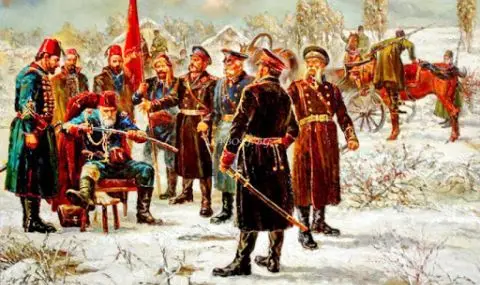On December 10, 1877 Pleven falls after a five-month siege. Osman Pasha surrenders the city and the garrison. The capture of the city of Pleven was an important moment in the Russo-Turkish War of Liberation, because by freeing significant Russian forces, after the Battle of Sheynovo at the beginning of 1878, the road to the Ottoman capital Istanbul was opened.
At the end of June in 1877, the Russian army crossed the Danube near Svishtov. The Russians capture Nikopol, and Osman Pasha leads his troops to Pleven. Shortly after, the first Russian military units began to arrive there. The siege and battle for Pleven took place in three assaults, with the first two assaults ending in failure.
After the failure of the two attacks of the Russian troops, Osman Pasha failed to take advantage of his advantage and repel the besieging troops. On 31 August he nevertheless launched a cavalry charge that cost the Russians 1,300 casualties to the Ottomans' 1,000. The Russians continued to send reinforcements to Pleven and their army reached 100,000 men under the personal command of Grand Duke Nikolai Nikolaevich. General Skobelev, recalls Pepa Tabakova in her blog.
On September 3, Skobelev captured Lovech, controlling the supply of the Ottoman forces from the south. The survivors of the hunting garrison were organized into 3 battalions, which strengthened the defense of Pleven. Osman Pasha also received additional reinforcements of 13 battalions, bringing his army to 30,000 men, the largest number for the entire siege. On September 11, the Russians launched a new large-scale attack on Pleven. Skobelev captured two redoubts on the southern side, and Romanian units captured the important Grivitsa redoubt from the north. On September 12, the Ottomans regained the southern redoubts, but failed to repel the Romanians from Grivica. From the beginning of September to this point, Russian losses amounted to about 20,000 men, while the Ottomans lost about 5,000.
Rising Russian casualties lead to an end to direct attacks and a change in command. The official head of the besieging forces was the Romanian prince Carol I, as his chief of staff was the Russian general Eduard Totleben, widely known for the defense of Sevastopol during the Crimean War. Totleben decided to completely surround and isolate the city, which was achieved after the Battle of Gorni Dabnik on October 24. Osman Pasha made a request to the command to abandon Pleven and retreat, but did not receive permission to do so. Deprived of supplies, he eventually attempted to break the siege. On December 9, Osman Pasha crossed the Vit River and attacked on a three-kilometer front, passing through the first line of Russian trenches. Outnumbering the Ottomans by almost five times, the Russians pushed them back across the river, and Osman Pasha himself was wounded in the battle. After briefly holding their ground, the Ottomans were driven back into the city, losing 5,000 men to the Russians' 2,000. On December 10, Osman Pasha surrendered the city and the garrison to the Russians.
